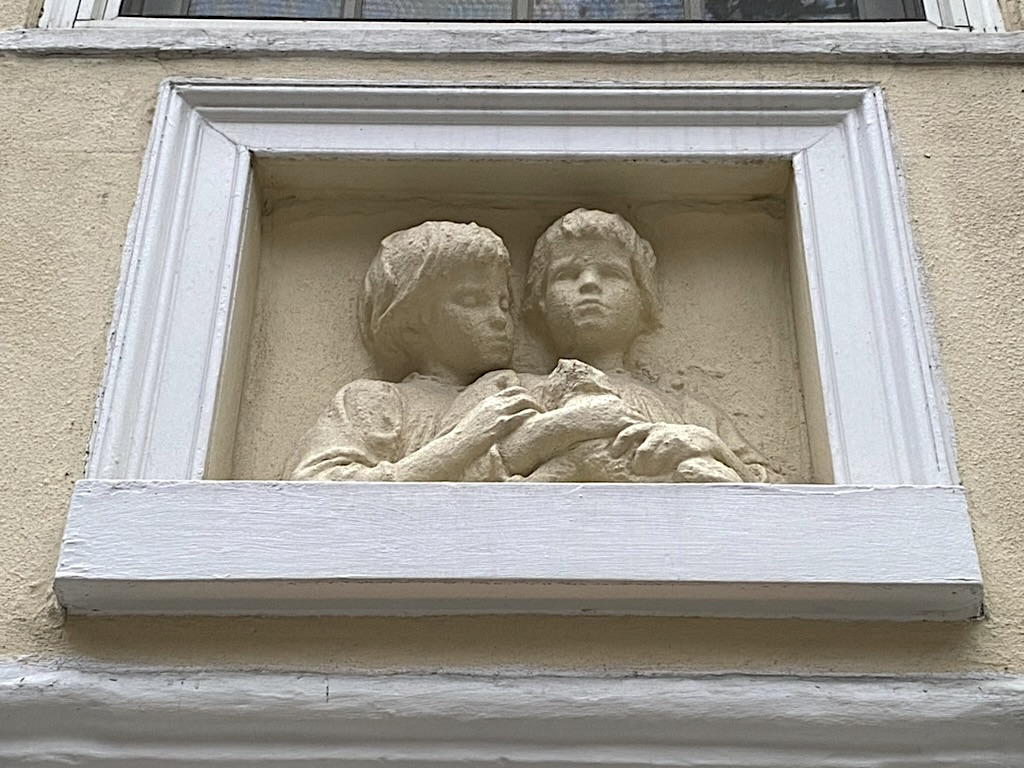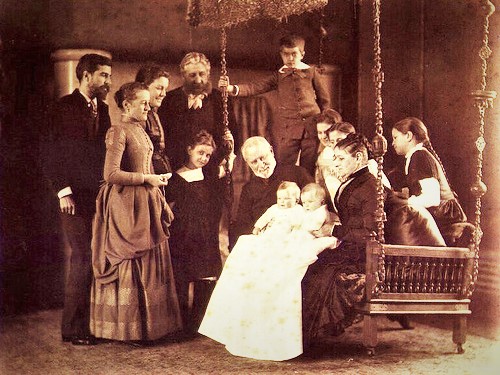It’s a charming scene on the facade of 328 East 51st Street: a boxy bas relief sculpture of two short-haired young children. One holds what seems to be a pet, perhaps a kitten, while the other looks on and touches it with tenderness.
Such a sweet depiction in a domestic setting would lead you to assume that the children were part of a family that once resided in the house, built in 1861 between First and Second Avenues.
Turns out the real-life children in the bas relief never lived at number 328; their childhood home was a stunning mansion farther uptown. And while questions remain about their connection to the artist who sculpted it, how it came to be installed above the door in the 1960s is less of a mystery.
First, the identity of the children: They are Julia and Louise Comfort Tiffany, the twin daughters of artist and designer Louis Comfort Tiffany, according to a New York Times FYI column from 2000 by Christopher Gray.
The twins were born in 1887 to Tiffany’s second wife. Julia and Louise are two of Tiffany’s eight children, and they resided with their parents in the Tiffany family mansion on 72nd Street and Madison Avenue. (Julia and Louise are the granddaughters of Charles Tiffany, founder of the jewelry store.)
The bas relief of the sisters was made by Mary Lawrence Tonetti, according to Gray. Born into a prominent old New York family, Tonetti was a rare female sculptor of the Gilded Age—studying at the Art Students League under Augustus Saint-Gaudens before becoming his assistant in the 1890s.
How did Tonetti come to sculpt the faces of Julia and Louise? “Neither the date nor the circumstances of the commission are known, but the Tiffany twins appear to be about 10 or 12 in the panel, which suggests it was done around 1900,” wrote Gray.
The connection between Tonetti and the Tiffany sisters appears to be lost to the ages. But Gray has an explanation for how the sculpture ended up on 328 East 51st Street.
The row house was purchased in 1965 by a former stage actress named Katharine Cornell. Cornell’s name might draw a blank today, but she gained fame in the 1930s and 1940s for her many starring turns on Broadway, playing the leads in 1931’s The Barretts of Wimpole Street and Romeo and Juliet in 1934.
Cornell’s leading-lady status was so solid, she was dubbed “first lady of the theater” by the critic (and Algonquin Round Table member) Alexander Woollcott, according to her 1974 New York Times obituary.
Cornell had been friendly with Tonetti when the two were neighbors in Sneden’s Landing, a small village on the Hudson River waterfront in Rockland County. Cornell had seen Tonetti’s sculpture of the Tiffany sisters and took a liking to it, according to Gray’s Times piece.
Tonetti died in 1945. When Cornell moved from Sneden’s Landing to East 51st Street in 1965, Tonetti’s daughter-in-law gave her a copy of the sculpture a housewarming present, states Gray.
Cornell passed away almost 50 years ago, and the row house has long since changed hands. But the young faces of Julia and Louise Comfort Tiffany remain—an anonymous ode to the innocence and wonder of two little girls.
This isn’t the only bas relief of children on a New York City residence. Outside a Gilded Age mansion on Riverside Drive and 89th Street, Isaac and Julia Rice installed this frieze of their six beloved children. Though weathered and faded, it still stands today.
[Third image: Wikipedia; fourth image: NYC Department of Records and Information Services]
Tags: 328 East 51st Street sculpture, Bas Relief Kids Faces East 51st Street, Bas Relief Row House East 51st Street, Julia Tiffany, Louise Comfort Tiffany, Sculpture of Kids at 328 East 51st Street






October 24, 2022 at 4:15 am |
I think the backstory is more interesting than the art, although the sculpture is quite poignant. Thank you for shedding light on what seems to be an endless source of fascinating corners of New York.
October 24, 2022 at 12:04 pm |
I agree that the story is more interesting. But I pass this house often and have always wondered if the two faces belonged to real children. It was wonderful to discover that they did, and who the kids actually are.
October 24, 2022 at 6:56 am |
Let’s do some info on the real Hell’s Kitchen.
October 24, 2022 at 8:33 am |
Great history.
Readers might recognize Katherine Cornell’s name from Stage Door Canteen:
https://youtube.com/watch?v=8vQT6A3uvy0 .
According to IMDb, that’s her only film appearance (also, two TV movies). Interesting to see someone speaking as herself and then with stage diction.
October 24, 2022 at 12:17 pm |
She is someone I always knew of, but did not know. Thank you for the further enlightenment. That’s the kind of thing for which I subscribe to this blog for.
October 24, 2022 at 12:37 pm
I just discovered her as well! Glad to get Cornell’s name and work out there though.
October 24, 2022 at 11:07 am |
In the 1958 59 season I worked at the Coconut Grove Playhouse in Miami with a variety of different backstage jobs. One of them was to take Ms. Cornell a small pot of tea every evening prior to her putting on her make up, etc. The play was Dear Liar with Brian Ahern. She was indeed a Great Lady. I had no idea that she has since been forgotten. Nor did I know that she had lived so near to me in NYC!
October 24, 2022 at 12:03 pm |
Thanks for sharing your personal connection to Ms. Cornell. Perhaps it’s just me who had never heard of her—I was impressed by her long list of stage credits. And her Turtle Bay row house is still quite lovely; I pass it often.
October 24, 2022 at 11:47 am |
Countrypaul–I think it was Arthur Danto who said, in essence, that the theory behind a work of art is what makes distunguishes a work of art from other objects. (That is how he distinguished Andy Warhol’s sculptures of Brillo boxes, which are all but distinguishable from the original, from the original.) Following that, one could say that sometimes the story behind a piece–like the bas-relief over that door–is, as you say, more interesting than the work itself, which isn’t without appeal.
I like the idea of the kids watching over the adults as they enter the house!
October 24, 2022 at 12:05 pm |
Thanks VV for this insight! And now I’m in a rabbit hole reading about Arthur Danto.
October 24, 2022 at 4:35 pm |
In the first sentence of my previous comment, “makes” should be struck. In the parenthetical sentence, I meant “all but indistinguishable.”
I think I wrote that comment after my second cup of coffee!